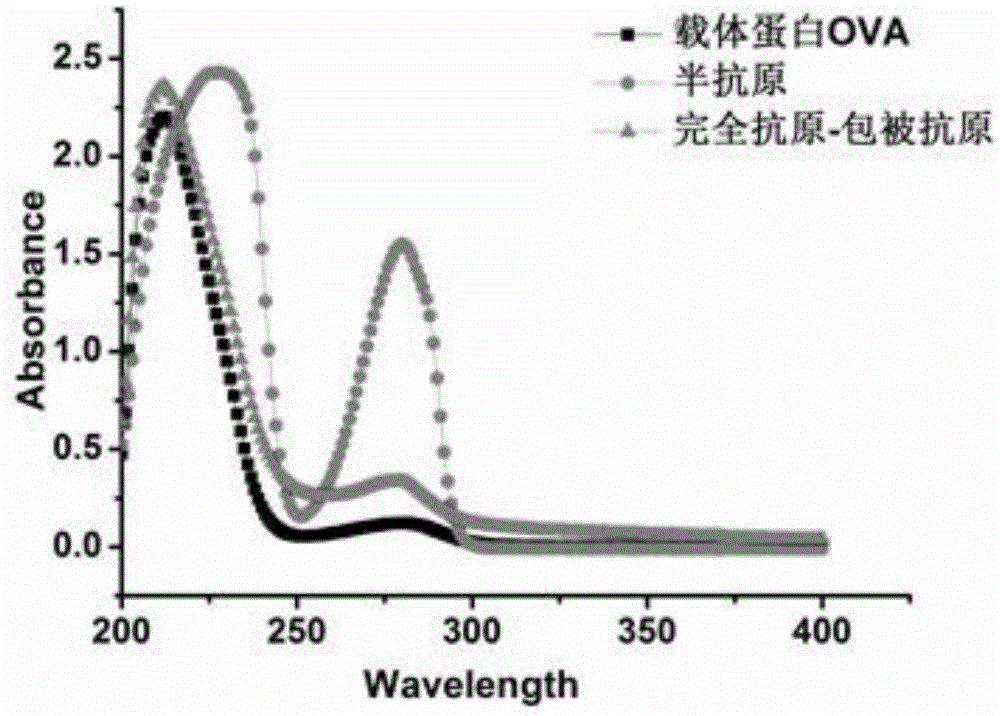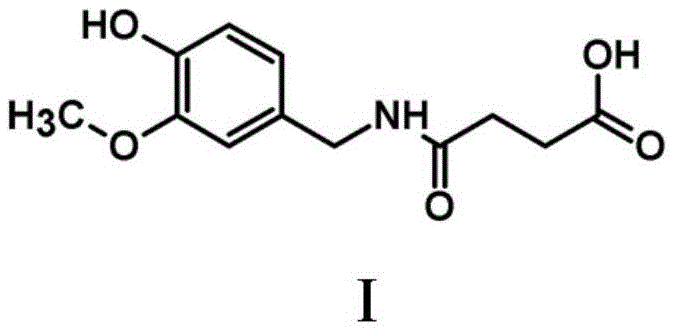Hybridoma cell line YQQD8 and general monoclonal antibodies produced by same to capsaicine, dihydrocapsaicin and nonivamide
A hybridoma cell line, a technology for synthesizing capsaicin, used in microorganism-based methods, microorganisms, biological testing, etc.
- Summary
- Abstract
- Description
- Claims
- Application Information
AI Technical Summary
Problems solved by technology
Method used
Image
Examples
Embodiment 1
[0021] The preparation of embodiment 1 capsaicinoid general artificial immune antigen
[0022] Preparation of general artificial hapten of capsaicinoids:
[0023]Weigh 0.28 g of vanillin amine hydrochloride and dissolve it in 6 ml of tetrahydrofuran, add 0.15 g of triethylamine dropwise with stirring, and stir at room temperature for 30 min. Accurately weigh 0.15 g (0.0015 mol) of succinic anhydride and add to the above reaction solution, and stir overnight at room temperature. Add 3 mL of ethyl acetate to the reaction solution and stir at room temperature for 2 min. After filtration, the resulting precipitate is the hapten 4-[(4-hydroxy-3-methoxy)benzylamino]-4-carbonylcarboxylic acid (4-[ (4-hydroxy-3-methoxybenzyl)amino]-4-oxobutanoic acid), the molecular formula is C 12 h 15 NO 5 .
[0024] The results of NMR identification are: 1 HNMR(400MHz,DMSO)δ12.17(s,1H),8.87(s,1H),8.31(d,J=6.0Hz,1H),4.21(d,J=5.8Hz,2H),3.80(s, 3H), 2.52(t, J=6.9Hz, 2H), 2.42(t, J=6.7Hz, 2H). ...
Embodiment 2
[0032] Embodiment 2: Preparation of animal immunization and hybridoma cell line YQQD8
[0033] 1. Animal immunization
[0034] Five 7-week-old BALB / c mice were purchased and immunized with the above-mentioned capsaicin-like artificial antigen-immune antigen. For the first immunization, the immune antigen was quickly mixed with an equal volume of Quick Antibody-Mouse5W (purchased from Beijing Boaolong Biotechnology Co., Ltd.), and then injected into the calf muscle of the mouse's hind leg to immunize the mouse. On the 21st day and 42nd day, the immunization was boosted in the same way. The dose of immune antigen used in the three immunizations was the same, 12.5 μg per mouse. Eight days after each immunization, blood was collected from the tail vein, serum was separated, and the serum titer of mice was monitored by indirect ELISA method. Eight days after the third immunization, blood was collected from the tail vein, and the serum was separated. The titer of the mouse serum ...
Embodiment 3
[0039] Embodiment 3: anti-capsaicin, dihydrocapsaicin, synthetic capsaicin universal monoclonal antibody hybridoma cell line YQQD8 antibody variable region sequence determination
[0040] (1) Extraction of total RNA: use the total RNA extraction kit of Tiangen Company and follow the instructions to extract the total RNA that can produce the hybridoma cell line YQQD8;
[0041] (2) Synthesis of cDNA: use the total RNA obtained in step 1 as a template, and oligo(dT)15 as a primer, perform reverse transcription according to the instructions of SuperScriptTM-2II reverse transcriptase, and synthesize the first strand of cDNA; primer oligo(dT)15 Purchased from Invitrogen;
[0042] (3) Cloning of variable region genes by PCR method: design primers according to the conserved sites of mouse antibody gene sequences in GENEBANK, and use cDNA as a template to amplify antibody light and heavy chain variable region genes. The PCR program was: 94°C for 30s, 55°C for 45s, 72°C for 1min, 30 cy...
PUM
 Login to View More
Login to View More Abstract
Description
Claims
Application Information
 Login to View More
Login to View More - R&D
- Intellectual Property
- Life Sciences
- Materials
- Tech Scout
- Unparalleled Data Quality
- Higher Quality Content
- 60% Fewer Hallucinations
Browse by: Latest US Patents, China's latest patents, Technical Efficacy Thesaurus, Application Domain, Technology Topic, Popular Technical Reports.
© 2025 PatSnap. All rights reserved.Legal|Privacy policy|Modern Slavery Act Transparency Statement|Sitemap|About US| Contact US: help@patsnap.com



